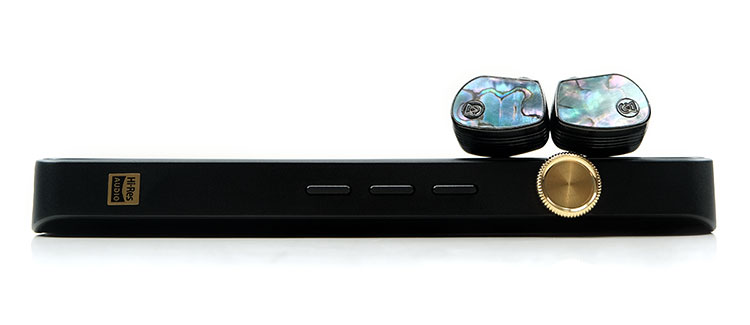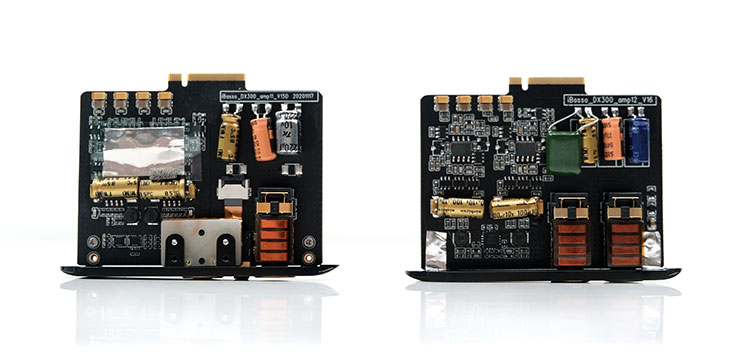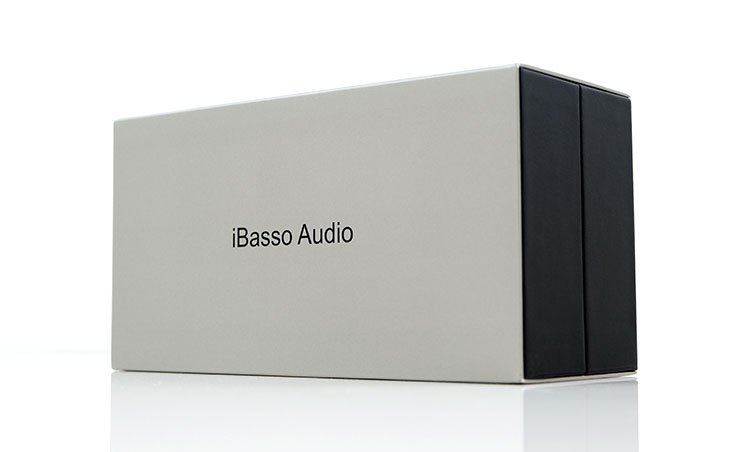Comparison with AMP11 MKI
Sound Impressions
The difference between these two is like starting out with a lively SET amplifier, (AMP11 MK1) then moving over to a dynamic but refined Class A solid-state alternative, (AMP12).
It is not so much that AMP12 puts the proverbial foot on the brakes compared to AMP11, but rather it tidies everything up a little, injects a bit more spaciousness, especially in the mids, and extends the upper treble to help reinforce the perception having a bit more to offer in terms of instrumental separation.
On the low-end, AMP11 MKI does sound a little fuller, with more warmth and longer note decay. It does very well in filling up the presentation and also has a substantial influence on the general timbre of the DX300. Many, including myself, will tend to refer to the AMP11 MK1 as an analog-sounding card.
AMP12 has a cleaner timbre with more of a classic solid-state energetic response on the low-end. It extends just as well with a slightly punchier mid-bass, a tighter decay, but not as much liquid warmth. For me, the low-end sound is more controlled or refined on AMP12 with a quicker transient response.
One of the other notable tweaks is the vocal positioning, especially the upper mids. You tend to notice it a lot more with upper-mids forward tuned monitors such as the Empire Ears Odin. Here I felt the AMP11’s vocal imaging to be more aggressive and fuller sounding whereas the AMP12 sounded more neutral, both in terms of weight and imaging.
Overall, AMP12 has a more articulate staging quality, better instrumental separation, and the blacker background. AMP11 MK1 is more emotive with a richer warmer timbre, forward vocals, and the more forgiving of the two for general listening.
Technical Differences
AMP11 MK1 is the stock card that came with the DX300 when originally launched at the start of 2021 and like AMP12 it is also a discreet design pulling on the heritage of the older DX2XX AMP8 card.
There is no design difference between the two in terms of form factor but externally the AMP11 offers an additional 2.5mm TRRS balanced and 3.5mm SE PO as well as 4.4mm PO whereas the AMP12 only offers 4.4mm PO and a 4.4mm LO.
The big difference here is the internal circuit design and secondary to that the general performance numbers. The AMP12 can offer better maximum output power at 8.3Vrms compared to 7.1Vrms from the equivalent 4.4mm AMP11 output making the AMP12 potentially more suitable for demanding headphones.
Of course, if you are a 3.5mm or 2.5mm TRSS user then the AMP11 is the right choice for you but if you want a proper dedicated line out as well as 4.4mm PO, then the unique balanced circuitry of AMP12 is the better card.
However, even at lower PO loads, going balanced does favor lighter loads on the AMP12 with a slightly better dynamic range at 126dB compared to 125dB from the AMP11 and a 6dB advantage for THD+N so here more power does not mean a higher noise floor.
Synergy
Noise Floor
AMP12 is rated at 8.3Vrms maximum output which is more powerful than the original AMP11 at 7.1Vrms balanced. There is no SE but you need not worry about noise and background hiss from the more powerful balanced output. The AMP12 is probably iBasso’s best amp card to date for delivering a very black background.
Paired with one of the most sensitive monitors out there, Campfire Audio Solaris SE, the AMP12 delivered a crazy low noise floor and almost no hiss at all. AMP12 is almost on the same level as the excellent Lotoo PAW Gold Touch‘s balanced output for low noise with sensitive monitors such as the Solaris.
I would still say something like Empire Ears’ Zeus will challenge AMP12’s noise floor, however. You are still going to get some hiss with that pairing but it is my most sensitive IEM in the collection and doesn’t play fair with the majority of my sources. With the Zeus, the Lotoo PAW Gold Touch does have a slightly lower noise performance out of its 4.4mm balanced output for PO.
Line Out
This might be the secret sauce and for many the reason to get the AMP12 over either of the AMP11 alternatives. This is a dedicated or true balanced line out with digital attenuation capability meaning true balanced line-in portable amps and desktop amps will receive that 4.Vrms as a steady signal direct from the DAC rather than double amped.
Portable amplifiers such as the Cayin C9 are tailor-made for amp cards such as the AMP12 with its dedicated balanced LO and PO. The dynamic range here is excellent, the background very black and zero hiss with our test monitors, the 64 Audio U18s.
The presentation or timbre between the PO of the AMP12 and the LO is a little different. I suspect the AMP12 LO is relatively transparent in that regard as I get more of a taste of the core C9 tonality with more physicality to its sound quality.
Particularly in the vocal performance which sounded weightier and slightly further forward compared to the AMP12 PO’s clean but neutral level of note body. There is more of an ethereal overtone to AMP12’s PO performance with the more planted or firmer presentation coming from the LO into the C9.
IEM Pairings
There are a few monitor pairings that do very well with AMP12 that perhaps had one or two minor issues with AMP11. I had mentioned before the Odin synergy with AMP12 will favor those who want a little less aggression in higher pitching vocals or anything that generally crosses its forward upper mids tuning.
With AMP11 it is quite a bit more forceful and in your face, with AMP12’s more neutral midrange, the Odin has a little more balance with vocals dropping back marginally.
Now, I like vocals but I do find the AMP11 pairing to be a little more fatiguing with the Odin compared to AMP12. I also find the excellent dynamic range of the AMP12 to play out better with Odin’s TOTL resolving qualities, particularly in the articulate treble performance which offers more perceived headroom than AMP11.
Quite apart from the vocal positioning is the general timbre of AMP12 which is more neutral and cleaner compared to AMP11 MK1. BA monitors with a high level of technical capability such as the 64 Audio U18s sounded very articulate and holographic with the AMP12. The cleaner tone and tighter low-end of AMP12 also seem to gel very well with BA driver monitors.
Power
Whilst I don’t think AMP12 is quite hitting TOTL desktop-tier power, the dynamic range and voltage supply to some of my more demanding headphones are excellent. More so than AMP11 MK1.
Denser-sounding headphones such as the Dan Clark Audio Ether 2 delivered more than acceptable slam and offered up some excellent clarity. I preferred this pairing to the warmer sounding AMP11 MKI which didn’t quite offer the same headroom and separation which is something the Ether 2 tends to benefit from.
You will need to step up to high gain with the balanced output of the DX300/AMP12 pairing to get an optimal level of current control. On low gain, the Ether 2 was maxing out at 100 without really sounding like it had got into top gear.
Less demanding headphones such as the Meze Empyrean and Hifiman’s Ananda get more than enough current on medium gain mode for comfortable listening.
Of the two headphones, the Empyrean was the more satisfying pairing. The neutral positioning of the AMP12 vocals imaging suited Empyrean’s more forward upper midrange preventing it from sounding necessarily shouty. You also get a better level of treble clarity from the AMP12/Empyrean over the slightly softer and warmer AMP11 pairing.
The Ananda did very well in terms of staging but I tend to prefer how the AMP11 fleshed out the low-end to the mids a bit more. The Ananda mids are not the most forward around 1-3k so AMP11’s thicker signature tends to work better for me here.
Our Verdict
In a way, AMP12 is a bit of a return to iBasso’s house sound before AMP11 with a strong emphasis on staging prowess, a neutral to natural tonal clarity, and excellent dynamic range. Not that the AMP11 lacked dynamic range but rather it sounded different, analog in tone, and does present a clear contrast to AMP12 in terms of tonal contrast.
That contrast is not just in terms of tonal quality but also in their different user-case scenarios. If you are going balanced and need a true balanced line out then the AMP12 is the clear option here. If you need an SE output, perhaps also a 2.5mm TRRS for whatever cables you have then AMP11 is the only game in town thus far.
That has always been the selling point of recent iBasso DAPs, the ability to choose what you want to do with it and how you want it to sound. I have a feeling DX300 customers are going to gobble up AMP12 for both of the reasons above.
iBasso AMP12 Specifications
Output Specifications(Headphone Output)
- Output interface: 4.4mm Balanced
- Maximum output level: 8.3Vrms
- Frequency response: 10Hz-45kHz(+/-0.9dB)
- THD+N: -113dB(No Load), -112dB(300 ohm load), -107dB(32 ohm load)
- Dynamic range: 126dB
- Signal to noise ratio: 126dB
- Crosstalk: -115dB
Line-Out Specifications
- Maximum output level: 4.1Vrms
- THD+N: -116dB(No load)
- Dynamic range: 128dB
- Signal to noise ratio: 128dB
- Cross talk: -102dB







